MORE ABOUT THEYYAM
Theyyam is an artistic dance form where metaphysical thoughts and expressions of immortal souls are impersonated to a believer through a mortal body. Theyyam originated from "Kaliyattam" once practiced by the tribal community of north Kerala. Theyyam had grown to the present form through many transformations since it’s origin. Landlords and chieftains of those days are the main forces behind many of such transformations. The community and its body began to use this art to propagate the major theme of social enforcement. The artists are also encouraged by the authorities to introduce new themes into its traditional layers and classified different acts and expressions to match specific needs for their desire. The character representations were very broad. They range from mild to wild in representations. Theyyam is a sect in which old heroes are sanctified and worshipped as the guardians of villages and homes. Yet, it includes a complex universe centered on the belief that a man can—after suitable mental, physical and spiritual preliminaries—don the costume of a particular deity and then become that deity. In this elevated state he assumes superhuman and divine powers—speaking, moving, blessing and even healing as a god or goddess. What is crucial is that the person is not possessed by the spirit of the deity.
ESSENCE OF THEYYAM
The essence of Theyyam is like the enhancement of the efficacy of a "manthra" by its incremental repetition. It brings us a super temporal and superabundance feeling in spite of its inherent relationship with real life at its inception. In the case of Theyyam, when the spirit is propitiated, the living generations enlightened in them the purest and the loftiest intentions that the past represents. The articulate creation of masks and gears from natural sources are intended to make unknowns to known and unattainable to real. The dancer recreates its mythical and ritualistic imagination and systematically delivers the right moods through his body posters. The performer of Theyyam gets himself completely into the artistic rhythm. Even when the dancer breaks coconut against his forehead, cuts his forehead with the sword, or wears red-hot iron chain on his body as a mark of self-torture, he never goes out of rhythm. The person who performs Theyyam while delivering such metaphysical experiences and involves himself completely into the act traverses through three different stages. The first stage is one kind of impersonation by decorating himself with creative paintings and coverings made up of natural materials. The second stage helps him to involve a mental state of flight to mystic heights. The last stage is the accomplishments of the dancer submerged fully into the artistic rhythm of acting the story. Though the spectators feel that the actor is unconscious to the surroundings, the man who controls the technique of dance and rhythm in him is fully alive to the situation. In theatre acting, if the actor looses his control, the act is rated as substandard. Myths in their visual manifestations react to their physical environment and absorb the colors and forms from nature and transport them into a philosophy and emotion of exhaustion and sublimation. It's important to understand that Theyyam has a larger purpose that goes beyond the territories of performance - to all those in attendance, it assures assistance and security during times of crisis, promising to resolve all their conflicts. Which is why the current trend of adapting it to suit a new context is viewed with distaste.
DIVINE TOUCH OF THEYYAM
After the preliminary rituals, which are often complex and intense, an empowered man-don’s elaborate mask-like make up. The wearing of spectacular costume further enhances the illusion of becoming a divine being. The unique quality of Theyyam is that its deities can manifest themselves in the bodies of empowered men as dancer-performers, and appear before their devotees while interacting with them by answering questions, mocking the pompous, ridiculing the vain, and humiliating the arrogant. Many of the male gods are associated with Shiva, and the goddesses with Parvati. There are about 450 deities in the pantheon of Theyyam. Some are worshipped under different names in different localities, making it difficult to be exact about their numbers. Many of these have evolved out of the land, lives, social customs, and traditions of the devotees. Some are deified ancestral warrior heroes whose extraordinary exploits were seen as evidence of divinity. The same is true for the goddesses who lived and suffered as mortal women, and were later recognized as innocent and divine, such as Nharmbhil Bhagavathi and Muchilotu Bhagavathi. The performance is always preceded by preliminary rituals. Certain deities are initially honored with the tottam, or song ritual, when the artist, wearing a simple costume and with minimal makeup, sings the song that relates not only to the deity's myth, but also to the origins of his or her relationship with the particular shrine. For the more active warrior gods, a vellattam, or energetic ritual dance incorporating martial arts, is required. After this the performer will retire to a temporary structure to be made up and costumed as the actual Theyyam. When the moment comes, he will enter the shrine to complete the ancient and complex process that has already begun edging him out into an extraordinary otherness. The most sacred and powerful element of the costume, the mudi or headdress, is put on once the artist has been seated on a sacred stool in front of the sanctum. After this comes the actual moment of "becoming" the deity, the moment of crossing the line, as he stares into a small hand-held mirror. It is at this point that, almost imperceptibly, he slips into another state of being, his eyes widening as they focus not on his own reflection, but on the enigmatic features of a divine being. This is the moment of fusion, the defining moment known as mukhadarshanam, or the seeing of the face. It is the moment when a mortal becomes a god.
THEYYAM PERFORMER
‘Theyyam’ performers belong to one of the Hindu communities. Each individual caste has the right to perform certain deities and all performers must poses a wide range of extraordinary skills. They must know the ritual and character of every deity. They have the inherited right to perform, know-how to sing, dance with the drum, do the complicated make-up and dress their costumes. Theyyam artistes are male. It is not a profession or calling that can be adopted. The artist's shrine rights are always inherited from the mother's family and when he marries, he also acquires the shrine rights of his wife's family. The artistes share a common training and tradition in which the process of becoming the deity is achieved after intense mental, physical and spiritual preparation. All Theyyam artistes must be able to do much more than just perform. Every deity's physical appearance conforms to an image envisaged centuries ago in the dream or vision of a respected guru. An artist must know how to make the headdresses and costumes of all the deities, how to apply the face and body makeup in all the different styles and designs, how to sing, play the drums, and know the stories, songs, and character of each deity.
DEAR ALL, JUST CREATED A BLOG RELATED FAMOUS RITUAL DANCE OF NORTH MALABAR AREA OF KERALA STATE IN INDIA. YOU ARE MOST WELCOME ON YOUR OPINION ABOUT THIS WEBSITE
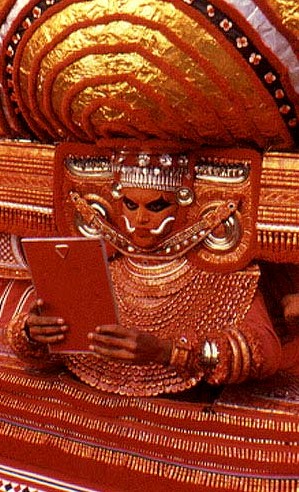
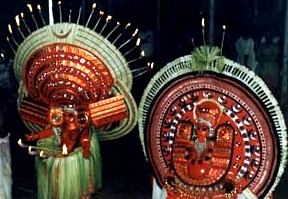
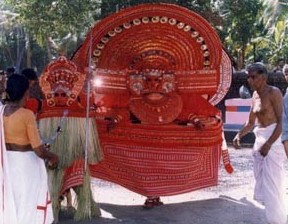
![]()
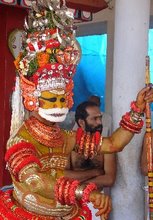
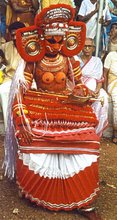
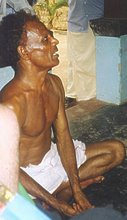
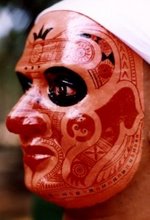
17 comments:
hello santhosh,
your theyyam blog is looks very nice... but i haven't read it...
how to give photo caption just below to the photo?...I have tried that and failed...
i have seen vengara website...beautiful...you are doing great effort for Vengarakkarrr...........
good.......
hi santosh,
i liked ur site.
i would like to know if u have information on,gullikan,pullivettakarumagan,oorpeseri,
sasthappan.if u have any info please let me know.
Hi ! any one can help me about the information of KATHIRANNOOR VEERAN's temple and his sidhi &moorthi details... please
Thanks &Regards.
Girish
Hi ! any one can help me about the information of KATHIRANNOOR VEERAN's temple and his sidhi &moorthi details... please
Thanks &Regards.
Girish
Hi ! any one can help me about the information of KATHIRANNOOR VEERAN's temple and his sidhi &moorthi details... please
Thanks &Regards.
Girish
Hi ! any one can help me about the information of KATHIRANNOOR VEERAN's temple and his sidhi &moorthi details... please mail to me...
Thanks &Regards.
Girish
sai.esha@yahoo.com,g_ikus@yahoo.com
Kuwait
Mob # 00965-97924053
Ok good site and nice informations. Well done. U can also see my blog www.theyyamcalendar.blogspot.com/
ok. But I am on modification work.
chandrankaden@yahoo.co.in
hi santhosh, read ur blog. i am planning to work on theyyam and modern Malayalam theater in kerela. Basic information where in Cochin can i get book on theater especially Kerala and rituals.
hi santosh,
i liked ur site.
i would like to know if u have information on,Dhanvanthari.if u have any info please let me know.
I have a big question...would you know any research work or paper related with theyyam.
Please , do let me know if you have any info. i will be extremely grateful to you....Raji.R,Sir Syed College,Taliparamba,Kannur
I'm very thanksful to you for this
informations.And pleas involv the
name of artists.
great blog.... actually helped alot.. why dont you add different types of theyyam also... like vannathan,chuzhali,vettekhuorumakahan... if m not wrong there are more than 100 hundred types of theyyam.. nyways great work... well done..
Hi santhosh
I don't know about you.But last 35 years i have been studying theyyam. But i can't say its merely an Art form. How did you describe its simply an art? 'Theyyam' is not an art And 'thyyakkaran' is nor an artist. Because Art is always accepting changes, but in theyyam there is not enough changes severel years. we can't remove any thing from the theyyam only for visual beauty. same time we can't add anything for the same purpose.
Most of the time Historians take initiative to represent all about past. That is the big mistakes. Because they are always saying depends up on the reference and collected materiel. Most of the time it should be fake. they tried to say their own vision and word. Actually its not true in in theyyam. I definitely not accepting it.Because they have to study more and more about theyyam. All historians trying to make history as an academic way. same time its not true. they always presented their own vision. I am proudly say 'Theyyam IS merely not an art.
it’s a
tradition
ritual
worship
custom
and culture
I'd like to know 'thottam kadhakal' of Muthappan, Shasthappan (is it right? "Shasthappan".) and Gulikan. I am doing a documentary about Theyyam.
It's a great blog. It helped me understand about this interesting ritual. Theyyam is about the spirit of rebellion that found expression in the fold of religion. I found this documentary on Theyyam while surfing youtube. You may watch it. https://www.youtube.com/watch?v=VA5gdIQjPZ8
Post a Comment